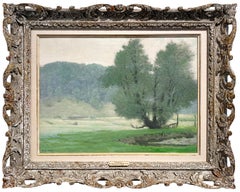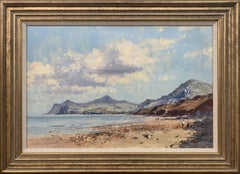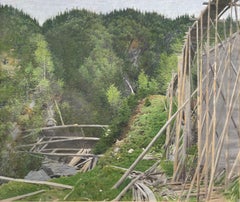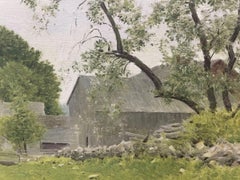Frank Vincent Dumond Paintings
American, 1865-1951
Born in Rochester, New York in 1865, Frank DuMond left his work as an illustrator at age 23 to study in the rigorous classical atelier tradition of the Academie Julian Paris in 1888. Upon his return to New York in 1892, DuMond embarked on a painting and teaching term at the Art Students League spanning nearly six decades until his death.
A painter of diverse talents, he was an accomplished landscape, portrait and still life painter, muralist, and leader of the Tonalist then Impressionist art colonies of Lyme, Connecticut. In particular, DuMond was noted for his use of landscape green. American Impressionist expert William H. Gerdts wrote of DuMond, "As one might speak of Velazquez's blacks, one must speak of DuMond's greens." Scholars have described him as a deft painter of the American Impressionist landscape and the figure, but he will perhaps be remembered as among the most outstanding educators in American art history. Though an accomplished painter, he is said to have considered himself more of an educator than an artist.
By all accounts, DuMond is described by his students as a man whose art and teaching methods were based on deeply held religious and philosophical beliefs. One student recalls, "There were occasions when DuMond revealed a clear intent to educate us on a deeper level than might casually be associated with painting." His students remember him fondly as "a genial, generous, and perceptive instructor…whose warmth and kindness pervaded everything he did." Under his tutelage, many prominent American artists were brought to recognition, including Georgia O'Keeffe, Norman Rockwell, and John Marin. Still other protégés of DuMond renown became influential teachers, such as Baroque-style painter Frank Mason, whose influence emerged in New York at the Art Students League; and Arthur Maynard and Alban Albert, whose influences emerged at the Ridgewood Art Institute to form another branch of DuMond student legacy.
It was in his early training in Paris that he absorbed the influences of his teacher Gustave Boulanger, Benjamin Constant and Jules-Joseph Lefebvre and the Barbizon and increasing popular Impressionist style. In frequent trips to the French countryside, DuMond was disciplined in painting the naturalistic landscape. Many Barbizon School landscape precepts-such as a sublime vision of the natural world, and an interest in the transient effects of light and shade to depict and dramatize it-have been handed down through generations of painters and continue to pervade art theory today.
Dumond's teaching continues to influence much of our present-day instruction. DuMond students were taught to see the progression of prismatic light flowing from yellow to red to violet on the warm side; and from yellow to green to blue-green to violet on the cool side.
Variations of the palette used by DuMond-consisting of premixed blues, grays, violets and greens in tonal progression from cadmium yellow to red are still used by many instructors at the Ridgewood Art Institute and by artists around the country.to
1
1
1
Overall Width
to
Overall Height
to
2
1
1
2
2
1
1
2
2
1
2
783
707
702
697
1
2
Artist: Frank Vincent Dumond
Trout Rock- American Impressionist
By Frank Vincent Dumond
Located in Miami, FL
This stunning work features Mr. Dumond's trademark green.
Trout Rock
Signed lower left: F. V. Dumond
Titled on stretcher with artist's estate stamp: Trout Rock
From a Texas Estate.
Frank Vincent Dumond was an artist, illustrator, and painter of the Tonalist school...
Category
1930s American Impressionist Frank Vincent Dumond Paintings
Materials
Oil
$20,000 Sale Price
20% Off
Willows, Old Lyme, CT Summer landscape
By Frank Vincent Dumond
Located in New York, NY
A gorgeously colored summer landscape by Important American Impressionist, Frank V Dumond. Fresh in color and elegant in the tonally complimentary French frame with silk liner. Atm...
Category
1910s Impressionist Frank Vincent Dumond Paintings
Materials
Oil, Board
Related Items
Landscape Seascape Painting of Coast from Nefyn in North Wales by British Artist
Located in Preston, GB
James Longueville PS PBSA (British Northern School)
Landscape Seascape Painting of Coast from Nefyn in North Wales by British Artist
Oil on board, sign...
Category
Late 20th Century Impressionist Frank Vincent Dumond Paintings
Materials
Board, Oil
$3,253 Sale Price
20% Off
H 26 in W 36 in D 3 in
Spanish School (XX) Fishermen's Beach oil on board painting seascape Spain
Located in Barcelona, Barcelona
Signed J. Sureda Lloveras - Fishermen's beach - Oil on board
Oil measures 33x41 cm.
Frameless.
Signed J. Sureda Lloveras.
Category
1940s Impressionist Frank Vincent Dumond Paintings
Materials
Oil, Board
$505 Sale Price
40% Off
H 13 in W 16.15 in
Grazing Cows - Farm Landscape
Located in Soquel, CA
Grazing cows on the California Big Sur coast, a farm landscape by J.W Ford (American, 20th Century). Signed "J.W Ford" lower right. Unframed. Image size, 16"H x...
Category
1970s American Impressionist Frank Vincent Dumond Paintings
Materials
Canvas, Oil
Texas Landscape with Cactus
Located in San Francisco, CA
This artwork titled "Texas Landscape with Cactus" c.1960 is an oil painting on canvas board by American artist Arnold Vail 1922-1995. It is signed at the l...
Category
Mid-20th Century American Impressionist Frank Vincent Dumond Paintings
Materials
Oil
Wells Fargo Express, Gold Country -- Columbia, California
By Cecil F. Chamberlin
Located in Soquel, CA
Charming oil painting of the Wells Fargo Express Office building in the gold country town of Columbia State Historic Park in Columbia, California by Cecil ...
Category
1950s American Impressionist Frank Vincent Dumond Paintings
Materials
Canvas, Oil, Illustration Board
$1,320 Sale Price
20% Off
H 27 in W 30.75 in D 2 in
19th Century Original Hudson River School Landscape - Fishing in Sierras
Located in Soquel, CA
1880s Century Original California School Oil Painting of Native Americans Fishing in Sierras by Ransome Gillet Holdredge
Wonderful landscape of Sierra Mountains in Hudson River Scho...
Category
1880s American Impressionist Frank Vincent Dumond Paintings
Materials
Oil, Raw Linen, Stretcher Bars
$5,525 Sale Price
35% Off
H 30 in W 50 in D 1.5 in
Olive trees Soller Mallorca Spain oil on board painting spanish landscape
Located in Barcelona, Barcelona
Title: Olive Trees, Sóller, Mallorca
Artist: José Ventosa Domènech (1897-1982)
Technique: Oil on panel
Unframed dimensions: 15 x 18 in
Framed dimensions: 23.6 x 26.7 in
Signature: Si...
Category
1950s Impressionist Frank Vincent Dumond Paintings
Materials
Oil, Board
$1,204 Sale Price
44% Off
H 14.97 in W 18.12 in
"Dior and Croissants" Impressionistic Oil Painting Woman in a Street Cafe Framed
By Cindy Shaoul
Located in New York, NY
This painting depicts an impressionistic cafe scene of a woman in a Dior dress immersed in the Parisian cityscape while sitting at an outdoor café table. She is dressed in a black ou...
Category
2010s American Impressionist Frank Vincent Dumond Paintings
Materials
Oil, Canvas
$650
H 12 in W 10 in D 1 in
Afternoon Stroll, American Impressionist, Figure on Forest Path, Landscape
Located in Wiscasset, ME
Juliet M. White was born in Philadelphia in 1880. She studied at the Philadelphia School of Design for Women, which became the largest art school for women in the United States. Its ...
Category
20th Century American Impressionist Frank Vincent Dumond Paintings
Materials
Canvas, Oil, Board
$2,300
H 16.75 in W 14.75 in
"The Lobster Boats at Gloucester" Impressionistic Maritime Oil Painting
Located in Soquel, CA
"The Lobster Boats at Gloucester" Impressionistic Maritime Oil Painting
Vibrant and lively painting of moored lobster fishing boats by F. Pileria Sunnyvale, California artist. Two l...
Category
Late 20th Century American Impressionist Frank Vincent Dumond Paintings
Materials
Canvas, Oil, Board
$950
H 28.25 in W 34.5 in D 2.5 in
"Paris is My First Love" Impressionistic Oil Painting Woman in Cafe with Chanel
By Cindy Shaoul
Located in New York, NY
This painting depicts an impressionistic cafe scene of a Woman in Chanel. The thick brush strokes and fun marks creates an atmosphere reminiscent of the impressionists from the 20th ...
Category
2010s American Impressionist Frank Vincent Dumond Paintings
Materials
Oil, Canvas
$1,800
H 24 in W 20 in D 0.75 in
Visiting Day -- Mid Century California Figurative Landscape
Located in Soquel, CA
Charming and bright mid century California figurative landscape with a female figure walking down a verdant and inviting path by William Hiller (America...
Category
1940s American Impressionist Frank Vincent Dumond Paintings
Materials
Linen, Oil
$1,480 Sale Price
20% Off
H 22 in W 19 in D 0.75 in
Previously Available Items
"The Train Trestle" Frank Dumond, American Impressionist Landscape Painting
By Frank Vincent Dumond
Located in New York, NY
Frank Vincent DuMond
The Train Trestle
Signed lower left
Oil on canvas
24 x 30 inches
rank Vincent DuMond was one of the most influential teacher-painters in 20th-century America. He was an illustrator and American Impressionist painter of portraits and landscapes, and a prominent teacher who instructed thousands of art students throughout a career spanning over fifty years.
Frank Vincent DuMond was born on August 20, 1865 in Rochester, New York, to Elisabeth and Alonzo DuMond, partner/owner of an ornamental iron works manufacturer. They also had a younger son, Frederick Melville DuMond (1867 - 1927). Frank DuMond was interested in drawing from a young age, and was involved in the local art scene in the early 1880s. He got a job creating illustrations for a sign painting business. After graduating from a Rochester public school, DuMond moved to New York City in 1884.
From 1884 to 1888, he attended the Art Students League of New York, studying under Carroll Beckwith and William Sartain. DuMond financed his art education by taking a job creating illustrations for New York's Daily Graphic newspaper. As a result of his fine work there, he was offered a job at Harper's Weekly. He also later did work for such magazines as Century, McClure's, and Scribner's.
He moved to Paris to continue his studies, as did his brother Frederick. From 1888 or 1889 to 1891, Frank DuMond attended the Académie Julian, where his instructors included Benjamin Constant, Jules Joseph Lefebvre, and Gustav Boulanger. He attained recognition in 1890 when a painting of his, Holy Family, exhibited at the Salon, was awarded a prestigious medal.
His early work was in the Art Nouveau style, then in Paris he was influenced by the Barbizon school, later becoming an Impressionist. In 1895 he married Helen Savier of Portland, Oregon, another artist. They spent five years painting in France, where he also held summer classes for the Art Students League, painting landscapes outdoors from dawn until sunset. In 1900 he was elected into the National Academy of Design, and became a full Academician in 1906.
DuMond exhibited at the Cotton States Exposition in Atlanta, the World's Columbian Exposition in Chicago, the Pan-American Exposition in Buffalo, and the Saint Louis Exposition. He served as director of fine arts at the Lewis and Clark Centennial Exposition in Portland in 1905, and he helped organize the first exhibition at the Portland Art Museum that year. For the 1915 Panama-Pacific Exposition, he prepared two huge murals, 12 feet high by 47 feet long, which now hang in the San Francisco Public Library.
The editor of Harper's, who was also president of the Art Students League, convinced him to take a job teaching at the League. He still performed illustration work for a while in addition to teaching, including the artwork for Mark Twain's Personal Recollections of Joan of Arc.
In a teaching career spanning more than fifty years, DuMond taught thousands of artists at the Art Students League. His students included Norman Rockwell, Georgia O'Keeffe, John Marin, Frank J. Reilly, Charles Webster Hawthorne, Frank Herbert Mason, Ogden Pleissner, Kenneth Hayes Miller, Louis Bouché, Eugene Speicher, Helen Winslow...
Category
Early 20th Century American Impressionist Frank Vincent Dumond Paintings
Materials
Oil, Canvas
"Old Lyme Farm, Connecticut" Frank Vincent DuMond, Impressionist Landscape
By Frank Vincent Dumond
Located in New York, NY
Frank Vincent DuMond
Old Lyme Farm, Connecticut, circa 1900
Signed lower right; estate stamped on the frame
Oil on board
10 x 14 inches
Provenance:
The artist
Estate of the artist
P...
Category
Early 1900s American Impressionist Frank Vincent Dumond Paintings
Materials
Oil, Board
"Train Trestle, " Frank DuMond, Old Lyme Connecticut Impressionism Landscape
By Frank Vincent Dumond
Located in New York, NY
Frank Vincent DuMond (1865 - 1951)
Train Trestle
Oil on canvas
24 x 30 inches
Signed lower left; estate stamped on the reverse
Provenance:
Estate of the...
Category
Early 20th Century American Impressionist Frank Vincent Dumond Paintings
Materials
Canvas, Oil
Moments Rest, 1885 Frank Vincent DuMond
By Frank Vincent Dumond
Located in Soquel, CA
19th Century watercolor of a boy with a Horse drawn cart at feeding time, 1885 by Frank Vincent DuMond (American, 1865-1951). Signed on verso torn paper backing piece. Image with mat crop, 4.5"H x 7.5"W, Image full paper size, 5.13"H x 7.88"W. Cardboard size, 8.75"H x 8.75"L. paper has slight age toning, glued to irregular cardboard backing with losses to cardboard due to age: 1885. In a Giltwood frame.
Born in Rochester, New York in 1865, Frank DuMond left his work as an illustrator at age 23 to study in the rigorous classical atelier tradition of the Academie Julian Paris in 1888. Upon his return to New York in 1892, DuMond embarked on a painting and teaching term at the Art Students League spanning nearly six decades until his death.
A painter of diverse talents, he was an accomplished landscape, portrait and still life painter, muralist, and leader of the Tonalist then Impressionist art colonies of Lyme, Connecticut. In particular, DuMond was noted for his use of landscape green. American Impressionist expert William H. Gerdts wrote of DuMond, "As one might speak of Velazquez's blacks, one must speak of DuMond's greens." Scholars have described him as a deft painter of the American Impressionist landscape and the figure, but he will perhaps be remembered as among the most outstanding educators in American art history. Though an accomplished painter, he is said to have considered himself more of an educator than an artist.
By all accounts, DuMond is described by his students as a man whose art and teaching methods were based on deeply held religious and philosophical beliefs. One student recalls, "There were occasions when DuMond revealed a clear intent to educate us on a deeper level than might casually be associated with painting." His students remember him fondly as "a genial, generous, and perceptive instructor…whose warmth and kindness pervaded everything he did." Under his tutelage, many prominent American artists were brought to recognition, including Georgia O'Keeffe, Norman Rockwell, and John Marin. Still other protégés of DuMond renown became influential teachers, such as Baroque-style painter Frank Mason, whose influence emerged in New York at the Art Students League; and Arthur Maynard...
Category
1880s American Impressionist Frank Vincent Dumond Paintings
Materials
Watercolor, Rag Paper
Frank Vincent Dumond paintings for sale on 1stDibs.
Find a wide variety of authentic Frank Vincent Dumond paintings available for sale on 1stDibs. You can also browse by medium to find art by Frank Vincent Dumond in oil paint, paint, canvas and more. Much of the original work by this artist or collective was created during the 20th century and is mostly associated with the Impressionist style. Not every interior allows for large Frank Vincent Dumond paintings, so small editions measuring 22 inches across are available. Customers who are interested in this artist might also find the work of Henry Bayley Snell, William Lester Stevens, and Victor Coleman Anderson. Frank Vincent Dumond paintings prices can differ depending upon medium, time period and other attributes. On 1stDibs, the price for these items starts at $7,500 and tops out at $25,000, while the average work can sell for $10,700.




